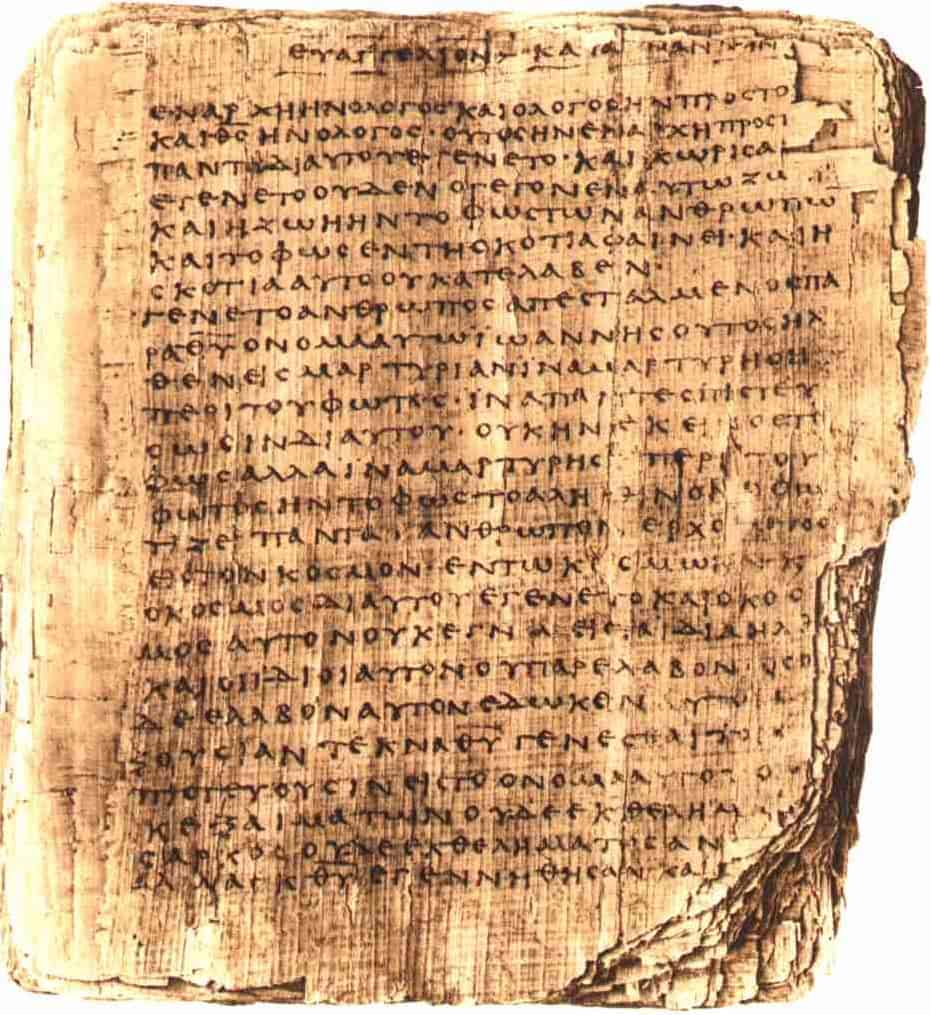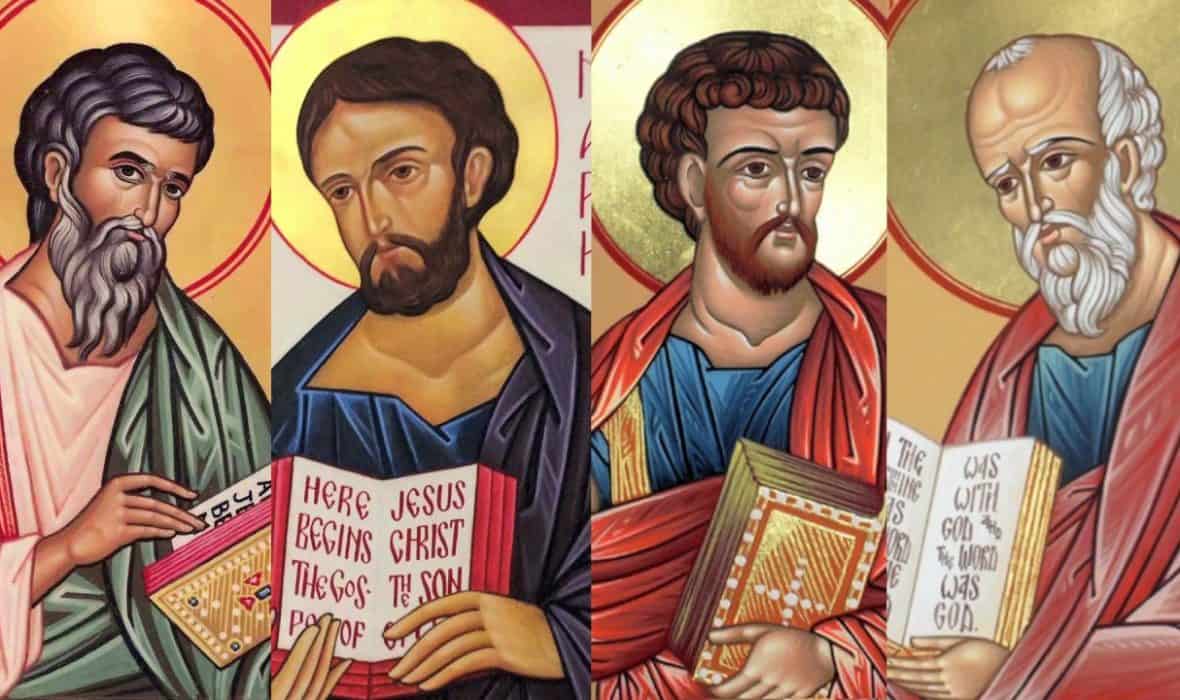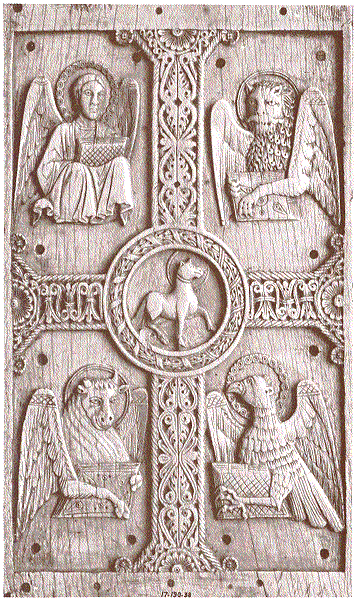Open your Bible to the table of contents and take a look at the list of books in the New Testament. There, you’ll find the Gospels according to Matthew, Mark, Luke, and John leading the list. But were Matthew, Mark, Luke, and John really the ones who wrote the Gospels? If so, how do we know?
Your first reply might be, Of course, Matthew, Mark, Luke, and John wrote the Gospels; their names are right there on the books!—and you would be correct. These four names have appeared on the manuscripts of these four Gospels for well over a thousand years. And yet, these names may not have been present on the earliest manuscripts of the Gospels. In fact, when it comes to the question of who wrote the Gospels, some scholars are quite convinced that Matthew, Mark, Luke, and John couldn’t possibly have been the authors of these four books. According to New Testament scholar Bart Ehrman,
[The New Testament Gospels] were written thirty-five to sixty-five years after Jesus’ death, … not by people who were eyewitnesses, but by people living later. … Where did these people get their information from? … After the days of Jesus, people started telling stories about him in order to convert others to the faith. … When … Christians recognized the need for apostolic authorities, they attributed these books to apostles (Matthew and John) and close companions of apostles (Mark, the secretary of Peter; and Luke the traveling companion of Paul). … Because our surviving Greek manuscripts provide such a wide variety of (different) titles for the Gospels, textual scholars have long realized that their familiar names (e.g., “The Gospel According to Matthew”) do not go back to a single “original” title, but were added later by scribes.*
If these claims are correct, early Christians did not link the four New Testament Gospels to Matthew, Mark, Luke, and John because these individuals actually wrote the Gospels. The Gospels were, according to Bart Ehrman and others, originally anonymous. According to this reconstruction, early Christians forged apostolic links in the second century in order to make these documents seem more authoritative. Ehrman’s proof for this supposition is the “wide variety” of different titles found among the Gospel manuscripts.
But does this reconstruction of who wrote the Gospels actually make the best sense of the historical evidence?
With this question in mind, let’s take a careful and critical look at the likelihood that the four New Testament Gospels actually originated with Matthew, Mark, Luke, and John. You can find more details about what I’ve written here in my book Why Should I Trust the Bible?—but I’ve included enough content in this post to help you to begin to understand the issues and to think more deeply about the possibilities.
 The earliest Gospel manuscripts in which the titles have survived seem to have been copied in the late second and early third centuries (Papyrus 66 and perhaps Papyrus 4 and Papyrus 75); that’s a century or more after the Gospels were originally written. And that’s one part of the evidence that causes some scholars to make the claim that the New Testament Gospels were originally anonymous.
The earliest Gospel manuscripts in which the titles have survived seem to have been copied in the late second and early third centuries (Papyrus 66 and perhaps Papyrus 4 and Papyrus 75); that’s a century or more after the Gospels were originally written. And that’s one part of the evidence that causes some scholars to make the claim that the New Testament Gospels were originally anonymous.
 But does this absence of titles provide evidence that the Gospels had circulated anonymously and that the titles were added in the second century A.D.? I’m not convinced that it does.
But does this absence of titles provide evidence that the Gospels had circulated anonymously and that the titles were added in the second century A.D.? I’m not convinced that it does.
In the first place, many of the earliest Gospel manuscripts have not survived sufficiently intact for us to know whether or not the manuscripts originally included titles. The portions of the manuscripts that would have preserved the titles have crumbled into dust or become separated from the rest of the manuscripts over the centuries. Sometimes, the title of ancient manuscripts were written on the tops of pages, but they were also frequently inscribed on flyleaves at the beginning or end of a manuscript. In other cases, titles were written on tags—known as sillyboi—and sewn to the closing edges of documents. If titles were preserved on tags or flyleaves, it’s quite likely that these deteriorated or that they have been lost over the centuries. As such, the absence of titles on the surviving portions of manuscripts does not mean that no names were originally present in any portion of these manuscripts.
When we examine all the manuscripts that have survived sufficiently intact to include any title, here’s what we discover: not one of these manuscripts omits the ascription to the author. In every manuscript that has survived sufficiently intact for a title to be present, there is a title, and the title links the text to the same author that’s ascribed to that Gospel in your New Testament today. “The first and perhaps biggest problem for the theory of the anonymous Gospels is this: no anonymous copies of Matthew, Mark, Luke, or John have ever been found. They do not exist,” Brant Pitre has pointed out. “As far as we know, they never have.”
The “Wide Variety of (Different) Titles” That Isn’t That Wide After All
Why, then, do skeptical scholars continue to claim that the New Testament Gospels were originally anonymous?
According to Ehrman, it’s due to the “wide variety of (different) titles for the Gospels.” From his perspective, the variety of different titles in Gospel manuscripts demonstrates that the titles were added in different locations long after the books originally began to circulate.
But what type of “wide variety” of titles is actually present in Gospel manuscripts from the first few centuries of Christian faith?
In almost every instance, the “variety” is limited to whether the title is “According to” the author or whether the title is “Gospel According to” the author.
In some manuscripts, the title is “Gospel According to” the ascribed author; in others, the title is simply “According to” the author. The difference is the difference between a full title and an abbreviated title—nothing more. That abbreviation accounts for nearly every instance of Ehrman’s supposed “wide variety” in Gospel titles.
Which means his “wide variety” isn’t really that wide after all—especially when we recognize that, in the titled manuscripts of the New Testament Gospel, there are no variations in which authors are ascribed to which Gospels. For example, the title of Matthew’s Gospel in the manuscript known as Codex Washingtonianus is “Gospel According to Matthew,” while the title of the same Gospel in Codex Sinaiticus is “According to Matthew”—but both codices explicitly ascribe the Gospel to the same source, Matthew. In the same way, Mark’s Gospel in Codex Alexandrinus is “Gospel According to Mark” whereas Codex Vaticanus has the abbreviated title “According to Mark” spread across the tops of two pages—but both recognize Mark as the author. This is the pattern that persists in every surviving Gospels manuscript that includes a title. Although the wording of the titles may differ slightly, the ascribed author never changes. Every titled manuscript of John ascribes authorship to John (never to Mark or Matthew or Peter or Andrew or anyone else), every titled manuscript of Luke ascribes authorship to Luke, and the same is true of every titled manuscript of Matthew and Mark.
What Would Have Happened If the Names Had Been Fabricated Later
Now that you understand this pattern, consider another vital bit of information: In the second century, the New Testament Gospels spread rather rapidly from church to church throughout the Roman Empire. Gospels could be found in Rome, where Justin the philosopher referred to Mark’s Gospel as “the memoirs” of Peter; in Asiana, where a pastor named Papias was gathering information about their origins from eyewitnesses; in Lyon, where another pastor known as Irenaeus relied on the four Gospels to refute heretical teachers in his church; and, probably as far as Egypt. Given the wide geographic distribution of the Gospels in the second century, what do you suppose would have happened if second-century Christians had suddenly decided to start fabricating names for the Gospels to make them seem authoritative?
Remember, Christians in one region could not quickly contact Christians in other regions, and—even if it had been possible to get the same information to everyone at the same time—there was no single human authority who could require all Christians everywhere to link the same titles with the same Gospels. As a result, if second-century Christians had fabricated the authors of the Gospels, one church might have christened a Gospel with the name of Andrew while another congregation ascribed the same Gospel to Peter or Thaddeus or Bartholomew. If that had occurred, we really would find Ehrman’s supposed “wide variety” in the manuscript titles. Each Gospel would have had a variety of different names in different manuscripts, depending on where in the Roman Empire your ship happened to land.
But that pattern is not even close to what we find when we examine the ancient manuscripts!
Throughout the titled manuscripts, the literary forms of the titles may shift—but the same author is ascribed to the same Gospel in every titled manuscript. Despite Ehrman’s confident pronouncement to the contrary, there is no “wide variety” of titles.
The Fantastic Four (and No More)
But all of this leads us to another question: In a world where communication was far from instant and the church was decentralized, how could the same authors’ names possibly have been linked to the same Gospels with such uniform consistency? I suggest that the most reasonable way to account for this uniformity is to recognize that each New Testament Gospel was linked to a particular author from the moment the text first began to circulate.
Perhaps this was because the authors’ names were inscribed on sillyboi or in flyleaves that told readers who wrote the Gospels. Or perhaps it was because of an oral history about each Gospel’s origins that was passed from church to church whenever one community of believers shared a Gospel with another community. Quite possibly, both of these phenomena were happening at the same time.
If an oral account of each Gospel’s origins or a written ascription did accompany each Gospel as soon as it began to circulate, it should not surprise us to find accounts of the origins of the Gospels in ancient sources separated by hundreds of miles. And, in fact, that’s precisely what we discover in words that have survived from the second century.
Let’s look at what second-century Christians—in locations ranging from Asiana to Italia to Gaul—had to say about who wrote the Gospels:
Papias of Hierapolis, born in the first century, writing in the early second century in the region now known as western Turkey: “Mark, having become Peter’s translator, wrote down accurately whatever he remembered. It was not, however, in exact order that he related the sayings or deeds of Christ. For he neither heard the Lord nor accompanied him. … He accompanied Peter, who accommodated his instructions to the necessities of his hearers, but with no intention of giving a ordered narrative of the Lord’s sayings. Wherefore Mark made no mistake in writing things as he remembered them. Of one thing he took special care, not to omit anything he had heard, and not to put anything fictitious into the statements. … Matthew put together sayings in the Hebrew language,* and each one translated them as best he could.” Papias gathered his information about who wrote the Gospels through conversations with eyewitnesses of the life of Jesus; his words were preserved by Eusebius of Caesarea from texts that he possessed in the fourth century.
Irenaeus of Lyon, born in the early second century, writing in the late second century from the region known today as France: “There are four Gospels and only four, neither more nor less. … Christ is at the center of them. John actually speaks of his kingly and glorious sonship to the Father in his opening words: ‘In the beginning was the Word.’ Luke begins with Zechariah offering a sacrifice. Matthew chooses first of all the Lord’s human genealogy. And Mark leads off by calling on the prophetic Spirit which invests humanity from on high. …Matthew issued a written Gospel among the Hebrews in their own language,* while Peter and Paul were preaching at Rome, and laying the foundations of the Church. After their departure, Mark, Peter’s follower and translator, handed down to us in writing what had been preached by Peter. Luke also, the companion of Paul, recorded in a book the Gospel preached by him. Afterwards, John, the disciple of the Lord, who also had leaned on his chest, published a Gospel during his residence at Ephesus in Asia.” Irenaeus probably gained at least some of his information through Polycarp of Smyrna, who was born in the first century and martyred in the mid-second century. Polycarp had been a companion of Papias; both Polycarp and Papias knew John the disciple of Jesus.
Muratorian Fragment, late second century, probably from Rome, on who wrote the Gospels According to Luke and John: [First portion of document has not survived] “…at which he was present, so he included them. The third book of the Gospel is according to Luke. Luke, the well-known physician, after the ascension of Christ, when Paul had taken with him as one zealous for the law, composed it in his own name, according to widespread belief. Yet he himself had not seen the Lord in the flesh; and therefore, as he was able to ascertain events, so indeed he begins to tell the story from the birth of John. The fourth of the Gospels is that of John, one of the disciples. To his fellow disciples and overseers, who had been urging him to write, he said, ‘Fast with me from today to the third day, and what will be revealed to each one of us, let us tell one another.’ In the same night it was revealed to Andrew, one of the apostles, that John should write down all things in his own name while all of them should review it. And so, though various elements may be taught in the individual books of the Gospels, nevertheless this makes no difference to the faith of believers, since by the one sovereign Spirit all things have been declared in all of them concerning the birth, the death, the resurrection, his life with his disciples, and his twofold coming; the first in lowliness when he was despised, which has taken place, the second glorious in royal power, which is still in the future.”
Irenaeus and the Muratorian Fragment testify together that, among second-century Christians in Rome and Lyon, only four Gospels were received as authoritative. From Papias and Irenaeus, we learn who wrote the Gospels known as Mark and Matthew. Mark recorded the words of Simon Peter, and the Gospel According to Matthew originated with an apostle and originally circulated in Hebrew characters.* Irenaeus and the Muratorian Fragment demonstrate that Paul’s companion Luke wrote the third Gospel while John’s Gospel was penned by a close companion of Jesus himself. What’s more, the earliest of these testimonies about the Gospels—the testimony of Papias—comes from a time when eyewitnesses of Jesus were still alive.
Who Wrote the Gospels?
And so, what do Gospel manuscripts and the words of second-century Christians reveal about the origins of the New Testament Gospels?
- There is virtually no evidence to suggest that the New Testament Gospels ever circulated anonymously. If the Gospels had been anonymous at first and their authorship had been fabricated later, the same Gospel would almost certainly have been ascribed to different authors in different regions. These variations would have shown up in later manuscripts and in citations in early Christian writings. Yet no such variations can be found. There is no “wide variety” of titles for the New Testament Gospels. The four Gospels were understood from their earliest stages of circulation to have originated with the apostles Matthew and John, Mark the translator of Peter, and Luke the traveling companion of Paul. This fact alone does not prove that Matthew, Mark, Luke, and John were the authors of the Gospels. It does, however, demonstrate that these names were attached to the Gospels from the time that the texts first began to circulate.
- Before the end of the second century, the New Testament Gospels were already a settled set of four books, with a clear tradition traceable through eyewitness testimonies to four particular first-century authors. Taken together, Papias, Irenaeus, and the Muratorian Fragment testify to the authority of four Gospels whose beginnings could be traced to Matthew, Mark, Luke, and John. In the cases of Papias and Irenaeus, these testimonies were traceable to individuals who had personally encountered Jesus and the apostles.
And so, who wrote the Gospels?
These ancient testimonies provide us with strong evidence that the names listed as the authors of the Gospels in the table of contents in your Bible were not later fabrications. The Gospels were known from the beginning to have come from particular individuals with ties to eyewitnesses of the risen Lord Jesus—two apostles and two close companions of apostles. The conclusion that makes the best sense of the historical evidence is that the content found in the New Testament Gospels could be traced back to four first-century Christians named Matthew, Mark, Luke, and John.
To learn more about who wrote the Gospels, take a look at my teaching series How We Got the Bible.
Appendix: Was Matthew’s Gospel Originally Written in Aramaic?
Both Papias and Irenaeus testify in their descriptions of who wrote the Gospels that Matthew’s Gospel originated in the language of the Hebrew people—by which they almost certainly intended Aramaic, which was the spoken language of the Jews at the time and which shares the same alphabet as Hebrew. No ancient Aramaic version of Matthew’s Gospel has, however, survived. The Gospel According to Matthew is in Greek. Further complicating matters, the version of Matthew’s Gospel that has survived in Greek reads smoothly and elegantly, not at all like a literal translation from Aramaic might read. Plus, Matthew’s Gospel incorporates much of Mark’s Gospel—often word-for-word. Many different solutions to this dilemma have been posited over the centuries. Here’s the reconstruction that I find most convincing, though others are certainly possible as well:
- Sometime prior to the mid-60s, the apostle Matthew wrote a Gospel in Aramaic, focusing on the teachings and sayings of Jesus.
- John Mark wrote a Gospel in Greek, based on Simon Peter’s accounts of the life of Jesus, in the mid-60s.
- Later in the first century or perhaps in the early second century, Matthew’s Aramaic Gospel was re-rendered into a Greek text that constituted a separate literary production distinct from the Aramaic version; portions of Mark’s Gospel and other testimonies were combined in this Gospel. The Greek version of the Gospel According to Matthew was widely accepted and in circulation no later than the early second century; Ignatius of Antioch, writing in the early second century, included a unique expression in Greek that alludes to Matthew’s Gospel (“plerosai pasan dikaiosunen“) in his letter to the Smyrneans (1:1, “plerothe pasa dikaiosune“). It is not inconceivable that the apostle Matthew approved this production of a Greek Gospel that greatly expanded his Aramaic Gospel, but that supposition in neither necessary nor provable. Ancient examples of a literary production in two different languages in two distinct editions from the same author can be found elsewhere. Less than a generation after Matthew’s Gospel, the Jewish historian Josephus produced two versions of his work The Jewish War—one in Greek and one in Aramaic—that seem to have presented overlapping content in two separate literary productions. The version in Greek is polished, with no evidence of being a wooden rendering of an Aramaic original. According to the description of Matthew’s Gospel found in the writings of Papias, each person translated the Aramaic edition of Matthew’s Gospel “as best he could.” The Greek version of Matthew that has survived to us may have constituted one of the translations described by Papias. The Gospel According to Matthew was thus rightly received by Christians as authoritative based on the apostolic authority of Matthew, because the distinct content of the Gospel was traced back to Matthew.
_________
* B. Ehrman, Jesus, Apocalyptic Prophet of a New Millennium (Oxford: Oxford University Press, 1999), 248-249; B. Ehrman, Lost Christianities (Oxford: Oxford University Press, 2005), 235; B. Ehrman and W. Craig, “Is There Historical Evidence for the Resurrection of Jesus?: A Debate between William Lane Craig and Bart Ehrman” (March 28, 2006).


